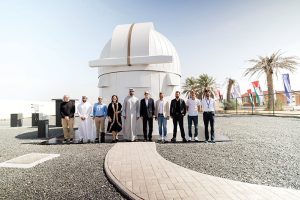ABU DHABI / WAM
The Technology Innovation Institute (TII), a leading global scientific research centre and the applied research pillar of Abu Dhabi’s Advanced Technology Research Council (ATRC), announced the opening of the Abu Dhabi Quantum Optical Ground Station (ADQOGS). The state-of-the-art facility, the first in the Arab world and largest in the Mena region is dedicated to developing secure free-space optical communications.
The station will seamlessly integrate Abu Dhabi and the wider UAE into the global Quantum Key Distribution (QKD) network. As one of the most mature quantum communications technologies, QKD enables secure and private communication by using quantum signals to establish encryption keys immune to tampering or interception. While the current optical fibre infrastructure is suitable for hosting metropolitan QKD networks for distances under a hundred kilometres, significant signal loss in long-distance fibre connections renders global-scale fibre-based quantum networks impractical. To bridge international distances, an architecture based on free-space optical transmission between satellites and ground-based receivers is currently the only viable solution. The ADQOGS will ensure regional connectivity, serving as a master station for the availability of ultra-secure key material, future-proofing secure networking in the UAE. The announcement further demonstrates TII’s ability to collaborate with the global research community building on its partnerships such as its collaboration with the National University of Singapore’s Centre for Quantum Technologies.
Located at Al Sadeem Observatory in Al Wathba, the 2,363 sqm facility hosts a fully automated astronomical dome housing an 800mm diameter tracking telescope, a control room for operational oversight, and a sophisticated weather station for sky monitoring and scintillation estimations. Complementing these facilities, a secondary platform will be made available to accommodate local and international portable optical ground stations, fostering collaboration in the sector.
At the heart of the facility, ADQOGS is equipped with a versatile Quantum Acquisition and Tracking system designed at TII. The fully automated quantum receiver module detects quantum signals within the 760 nm to 860 nm wavelength range, while a unique optical system design guarantees compatibility with a wide range of uplink and downlink beacons, supporting high throughput optical modulation schemes, ranging from 680 nm to 1,600 nm.
Speaking at the opening of ADQOGS, Dr Ray O Johnson, CEO, TII, said, “The inauguration of ADQOGS goes well beyond identifying and implementing disruptive technology — it is about cultivating a hub of innovation and knowledge. Our facility epitomises the pinnacle of quantum technology while serving as a centre of excellence for training, helping to nurture the emerging quantum technology sector in the UAE. For a relatively young entity such as ours, I am proud that we are actively shaping the future of secure data transmission on a global scale.”
Dr James Grieve, Senior Director of TII’s Quantum Research Centre, said, “ADQOGS marks an important milestone in the UAE’s pursuit of technological leadership. The station prioritises technological sovereignty in quantum communication, and it will bolster the country’s growing credibility in advanced technology and innovation, positioning the UAE as a global hub for quantum research and development.”
Ibrahim Hamza Al Qasim, Deputy Director-General at the UAE Space Agency, said, “We applaud this exciting new development that will give the UAE greater technological leadership in the very important field of secure communications. The UAE Space Agency is delighted to support this initiative, and we look forward to the outcomes of the first experiments.”
As part of ATRC’s vision to transform Abu Dhabi’s economic landscape, ADQOGS is committed to fast-tracking commercialisation opportunities in secure communication technologies and expanding their application across sectors such as telecommunications, data centres, finance, and critical infrastructure.
 The Gulf Time Newspaper One of the finest business newspapers in the UAE brought to you by our professional writers and editors.
The Gulf Time Newspaper One of the finest business newspapers in the UAE brought to you by our professional writers and editors.
